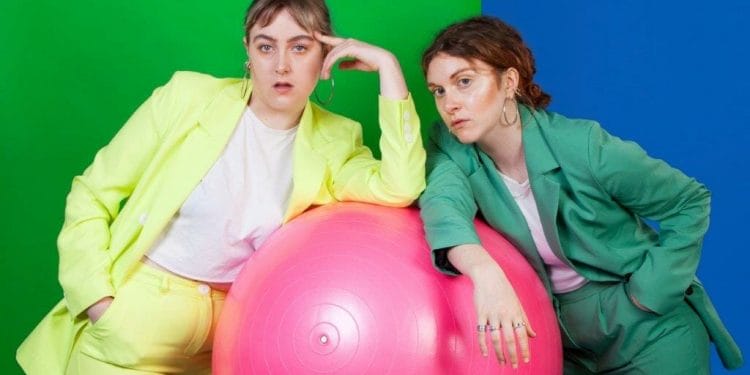Mary Higgins and Ell Potter have devised and star in FITTER which comes to the Soho Theatre from 3 December, running until 4 January 2020.
Following the critically acclaimed success of HOTTER most recently seen at Edinburgh Fringe, Mary and Ell asked trans-men, cis-men, and masculine presenting people aged 8 to 85 about what makes them hard.
You’re bringing FITTER to Soho Theatre. What can you tell us about it?
Hello! We’re Ell and Mary. We’re ex-girlfriends and bisexuals and we’re a bit bummed out by boys. We have a lot of unanswered questions about how they function and who the eff they think they are. So, we started asking those questions. We interviewed trans men, cis men, and masculine presenting people aged 8 to 102 (yep, 102) about what makes them hard. This is a show about what we learned: about strength, fitting in, feeling yourself, and arseholes. Part-verbatim-theatre, part-crap-drag show, FITTER is a love letter to masculinity that we’re forever tearing up and taping back together again.
Your previous show HOTTER was based on what women told you, why did you want to make a new show based on what men said?
We never second-guessed the fact that we didn’t want to interview cis men for HOTTER. I guess at the time we just weren’t interested in what they had to say, or didn’t think that they deserved a show dedicated to the male bodily experience. After the show cis men would sometimes come up to us and say ‘why didn’t you interview men for this show?’ Initially we laughed: oh how we laughed! Why would we make a show about men!!!??? They’ve had enough air-time already!!! Then we were like…oh. Maybe we should. We realised we had a lot of preconceptions about men (some fair, some unfair) that made us want to ignore them. FITTER is not only about what it means to be a man in 2019, but also about why, as queer women, we often feel so guarded towards men.
What is the biggest challenge for you in bringing these male voices to the stage?
We’re constantly questioning and justifying why it’s us making the show. Where do we, as queer female theatre makers, fit in? That’s why the autobiographical element of the show has to remain central: we’re not only listening to these male voices, trying to understand and empathise with them, we’re also always examining where we stand in relation to them. This means bringing into the show an element of personal experience — looking back at relationships we’ve had with men and how they’ve formed us as people. That’s been a challenge, because it means remembering traumatic experiences with the level of vivid detail needed to bring it all back to life on stage.
Did anything that was said really surprise you?
Listening to men talk about wanking was sometimes really difficult. It feels like womxn are going through a kind of wanking renaissance: self-love is cool; comparing notes on different types of vibrators is part of daily discourse; wanking is seen as something liberating and colourful and freeing and beautiful. But men haven’t really been invited to the self-love party. In our interviews we were shocked to find that, for people with penises, lots of first-wank experiences are clouded by shame: they describe secretly discovering masturbating without really knowing what it was, the early furtive discovery of porn, and the pressures to start wanking way earlier than they were ready to. The feeling that wanking is somehow inherently shameful still sits with a lot of the people we interviewed, even now. That was a sad realisation.
What inspired you to create this kind of show?
We were fed up with how much silence and embarrassment surrounds almost all bodily matters, from pooing to sweating to douching. We wanted whoever came to our shows to leave with a refreshed gratefulness for their own body, and a newfound love for their body’s idiosyncrasies. But we were also aware that we are speaking from really limited bodily experiences: we wanted to learn what life was like outside our cis white queer female bodies. So it was important to interview loads of different people from loads of different backgrounds, of diverse ages, races, and places.
What have these shows done to your own relationship with each other?
We’ve become closer and closer and closer. HOTTER had a kind of panic laced into it from the start: when we started writing it we had just got together and were discovering our queer identities for the first time. Then we broke up and were having our own sexuality-related-crises alongside show-related-crises: how could we carry on writing and performing together while nursing our heartbreak? It all felt impossible. But as time has passed it’s become easier and easier. We’re best mates and trust each other with anything and everything. Which is really important when you’re making theatre that has personal things at stake: you have to feel safe enough to push yourself to a vulnerable place, and you can only do that when you know you’ve got someone loving you unconditionally, standing right next to you on stage.
What would you say to anyone thinking of coming to see FITTER?
If you’re a womxn, get ready for your preconceptions about men to be changed, just like ours have. If you’re a man, FITTER is welcoming you to the body positivity party. We want FITTER to mark a shift in the perception of male/female bodily experiences as binarily opposed, challenging a culture of feminist art which excludes men from conversations about body image and which usually addresses masculinity only in its toxic and aggressive forms. Be ready to listen. ?
Main Image Credit: Mary Higgins and Ell Potter c. Holly Revell

















